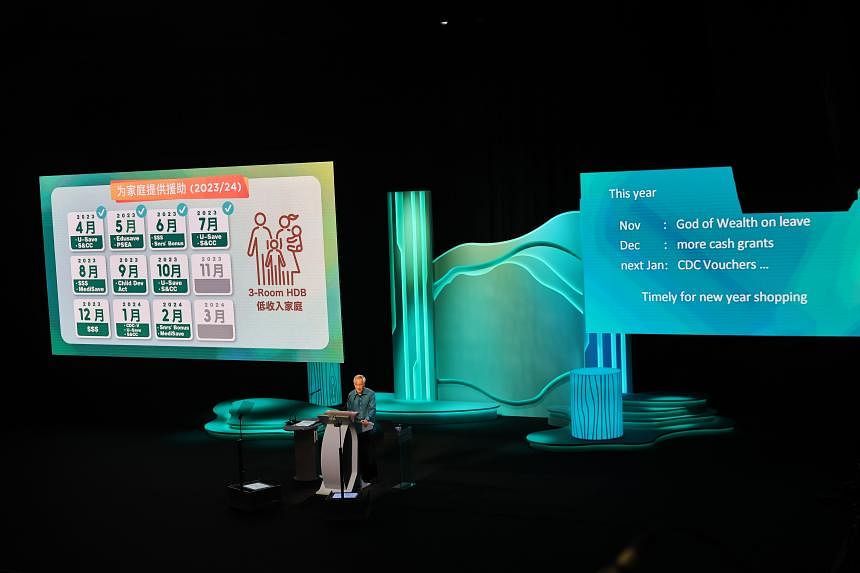NDR 2023: Reassurance amid winds of change
NDR 2023: Reassurance amid winds of change The Straits Times


Reassurance Provided in Prime Minister Lee Hsien Loong’s National Day Rally Speech

If there is one word to sum up what Prime Minister Lee Hsien Loong’s National Day Rally speech gave, it was reassurance – something we all need this year amid the slew of political scandals, persistent inflation, and concerns about prices of food and housing.
Reassurance was given in five areas: the cost of living, fair and affordable housing, jobs and skills, ageing and retirement adequacy, as well as political integrity and succession.
Introduction to the National Day Rally (NDR)
Before going into some of the highlights, it is worth noting that the National Day Rally (NDR) is seen as the most important political speech of the year.
While its exact substance varies from year to year, it generally covers these key aspects: immediate concerns, as well as medium- and long-term developments, including infrastructure.
For example, in 2022, it was Tuas Port, Changi Airport Terminal 5 and the redevelopment of Paya Lebar.
This year, a significant part was devoted to changes to the public housing model.
Geopolitics in the NDR Speech
When it comes to geopolitics, this part of the speech was low key in 2021, when Singapore was still in the throes of Covid-19. The focus then was more on lower-wage workers and pandemic resilience.
But in 2022, the external environment was given full play, with a sizeable chunk devoted to US-China tensions, Russia’s invasion of Ukraine, and the global economy.
This year’s speech started in largely the same vein, with the US-China rivalry, ongoing war in Europe, and a fraying global economic order.
Taken together, the different sections of each year’s speech paint the shifting landscape of Singapore, the external milieu in which it must exercise its choices and constraints, and tackle the changing needs and wants of Singaporeans.
Helping workers and lower- to middle-income Singaporeans
Beyond the substantive announcements, each NDR speech is also about striking a realistic but optimistic tone, acknowledging challenges while taking actionable steps to overcome them.
This year, on employment, PM Lee spoke of a temporary safety net to help workers who lose their jobs. It reinforces what Deputy Prime Minister and Finance Minister Lawrence Wong said in April, during the debate on the motion of thanks to the President’s Address in Parliament.
Mr Wong had spoken of a targeted re-employment scheme that seeks to avoid negative outcomes, such as displaced workers finding it more attractive to receive generous benefits than return to the workforce.
Today, there are schemes to help tide senior workers over while they find alternative employment, such as the Employment Assistance Payment.
SDGs, Targets, and Indicators
-
SDG 1: No Poverty
- Target 1.2: By 2030, reduce at least by half the proportion of men, women, and children of all ages living in poverty in all its dimensions according to national definitions.
- Indicator: Proportion of population living below the national poverty line.
-
SDG 3: Good Health and Well-being
- Target 3.8: Achieve universal health coverage, including financial risk protection, access to quality essential health-care services, and access to safe, effective, quality, and affordable essential medicines and vaccines for all.
- Indicator: Proportion of population with access to affordable essential medicines and vaccines.
-
SDG 4: Quality Education
- Target 4.4: By 2030, substantially increase the number of youth and adults who have relevant skills, including technical and vocational skills, for employment, decent jobs, and entrepreneurship.
- Indicator: Proportion of youth and adults with information and communications technology (ICT) skills, by type of skill.
-
SDG 5: Gender Equality
- Target 5.5: Ensure women’s full and effective participation and equal opportunities for leadership at all levels of decision-making in political, economic, and public life.
- Indicator: Proportion of seats held by women in national parliaments and local governments.
-
SDG 8: Decent Work and Economic Growth
- Target 8.5: By 2030, achieve full and productive employment and decent work for all women and men, including for young people and persons with disabilities, and equal pay for work of equal value.
- Indicator: Employment-to-population ratio by sex, age group, and persons with disabilities.
-
SDG 10: Reduced Inequalities
- Target 10.2: By 2030, empower and promote the social, economic, and political inclusion of all, irrespective of age, sex, disability, race, ethnicity, origin, religion, or economic or other status.
- Indicator: Proportion of people living below 50 percent of median income, by age, sex, and persons with disabilities.
-
SDG 11: Sustainable Cities and Communities
- Target 11.1: By 2030, ensure access for all to adequate, safe, and affordable housing and basic services and upgrade slums.
- Indicator: Proportion of urban population living in slums, informal settlements, or inadequate housing.
-
SDG 16: Peace, Justice, and Strong Institutions
- Target 16.6: Develop effective, accountable, and transparent institutions at all levels.
- Indicator: Proportion of population satisfied with their last experience of public services.
Behold! This splendid article springs forth from the wellspring of knowledge, shaped by a wondrous proprietary AI technology that delved into a vast ocean of data, illuminating the path towards the Sustainable Development Goals. Remember that all rights are reserved by SDG Investors LLC, empowering us to champion progress together.
Source: straitstimes.com

Join us, as fellow seekers of change, on a transformative journey at https://sdgtalks.ai/welcome, where you can become a member and actively contribute to shaping a brighter future.







